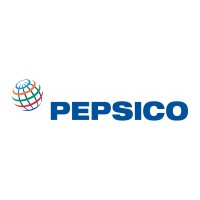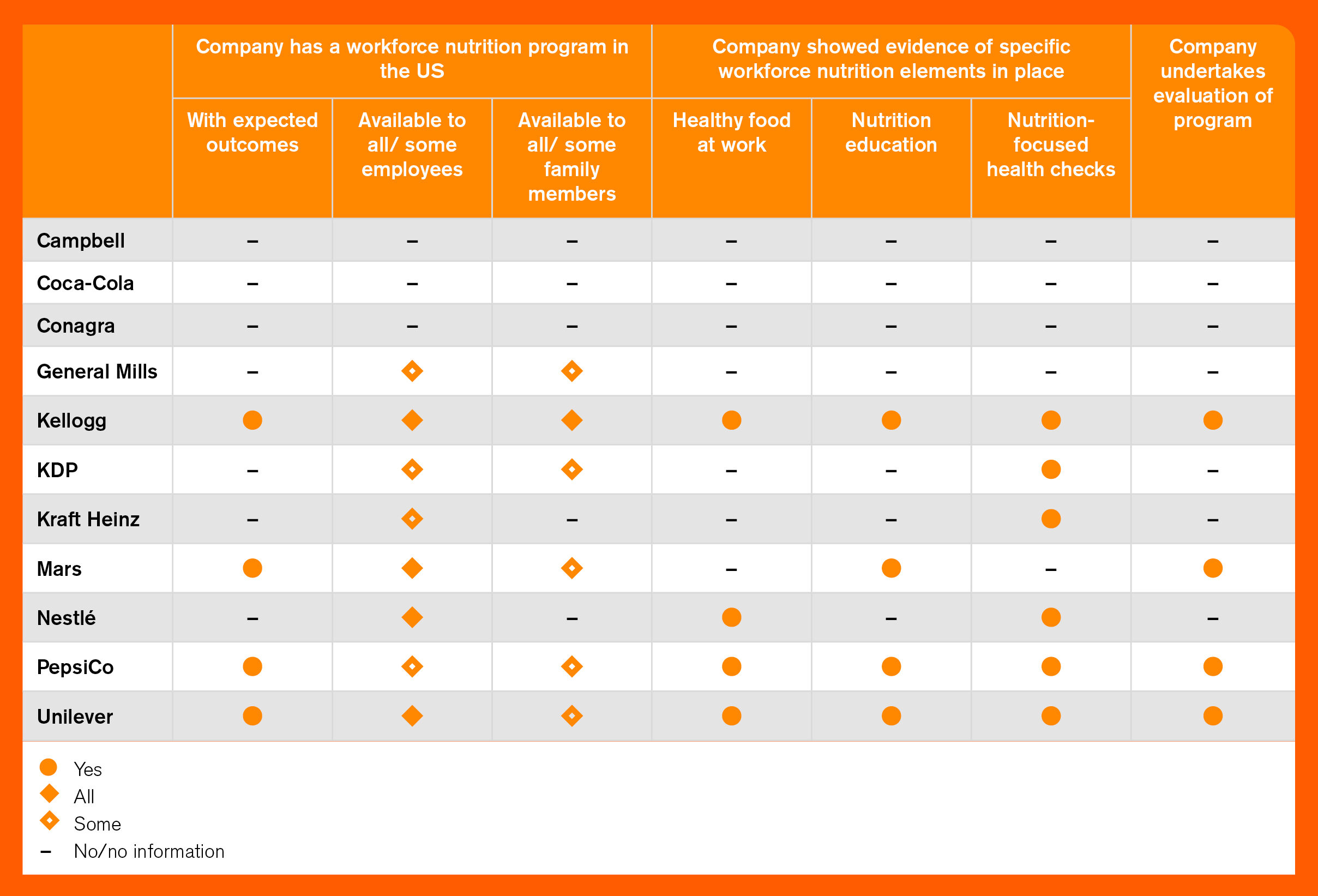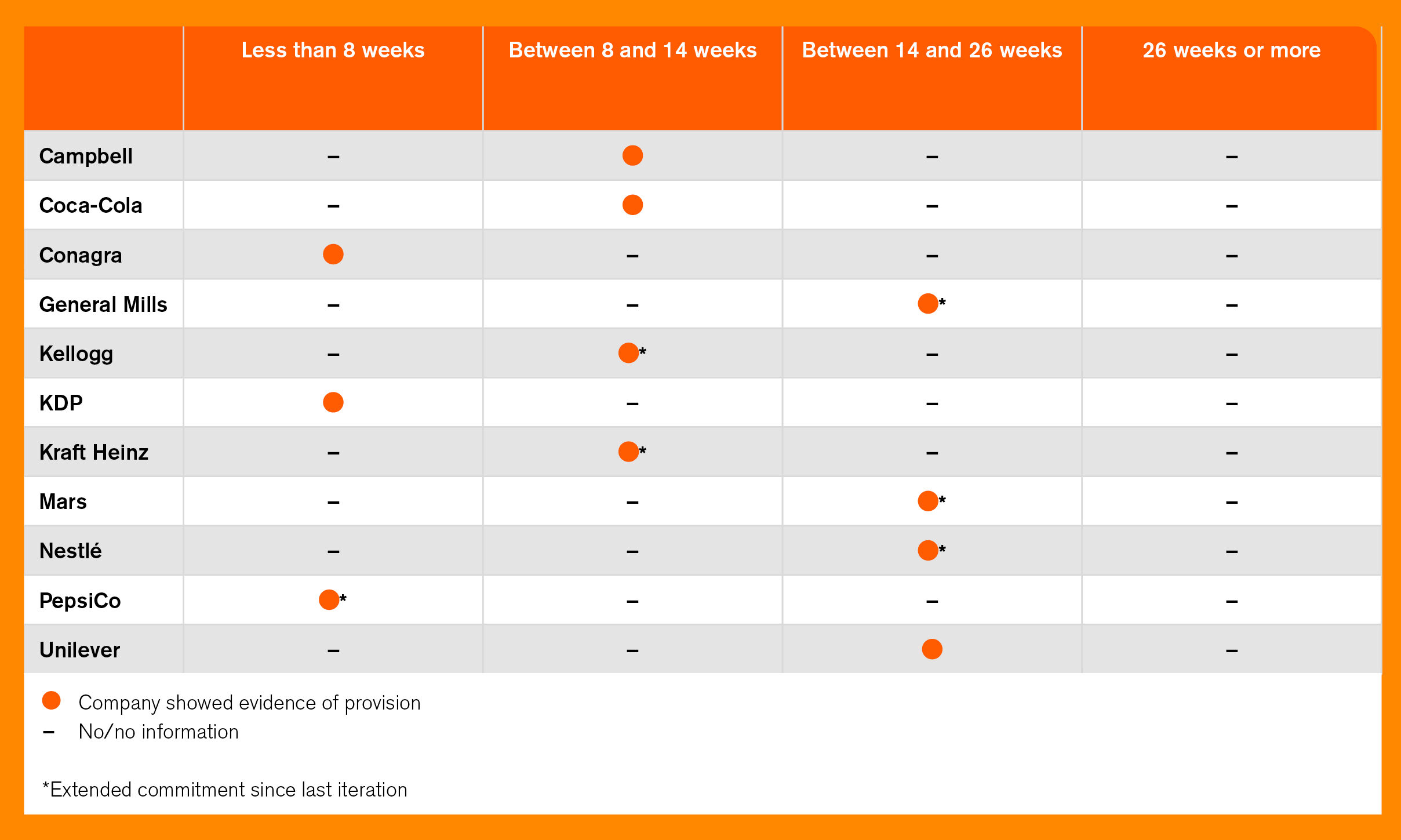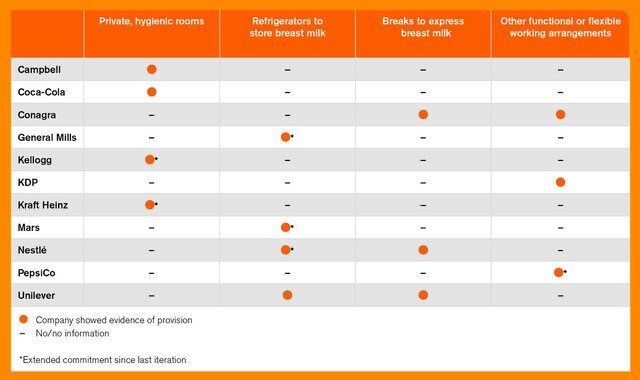Workforce Nutrition
Supporting healthy diets and nutrition programs in the workforce
Category E consists of two criteria:
- E1 Supporting Employee Health and Nutrition
- E2 Supporting Breastfeeding Mothers at Work
To perform well in this category, companies should:
- Publicly commit to support employee health and nutrition in the U.S. through a workforce nutrition program, which includes expected outcomes and is available to all employees and their family members.
- Implement a workforce nutrition program consisting of healthy food at work, nutrition education, and nutrition-focused health checks. Evaluate the program and publish information about the results.
- Formally grant paid parental leave of at minimum 14 weeks, as well as offering arrangements to support breastfeeding mothers in the workplace.
Ranking
- E1
- Employee health
- E2
- Breastfeeding support
Overall, scores decreased in Category E, with the average score decreasing from 4.1 to 3.7 out of 10. Unilever now leads the category with 7.3 out of 10, while Kellogg also demonstrated significant improvement. Being signatories of the WNA, both performed well in E1 and showed strong performance in E2. Kraft Heinz and KDP are also commended for improving their performance significantly, having both introduced new policies since 2018 regarding workforce nutrition and supporting breastfeeding mothers.
Category Context
Given that 58% of the global population spends at least one-third of their adult lives at work, workforce nutrition programs have been identified by the World Health Organization (WHO) as a key solution to addressing malnutrition. Studies have found returns on investment (ROI) of 6:1 for workforce health programs that include nutrition – finding positive associations with productivity and cognitive ability, along with reduced absenteeism, medical costs, and rates of accidents/mistakes. Workforce nutrition programs can also increase employee morale and motivation, improve employer/employee relations, and reduce staff turnover. In addition to these benefits, such programs can help facilitate a company culture with a greater focus on nutrition in its business practices.
The Workforce Nutrition Alliance (WNA, see Box 1) has identified four main types of effective workforce nutrition interventions for companies’ employees:
-
Healthy food at work. Programs that focus on increasing employees’ access to healthy and safe foods at work – either through direct provision or subsidy, or by increasing the availability of healthy food options in the setting.
-
Nutrition education. Programs aiming to change the nutrition and/or lifestyle behaviors of employees through increasing employees’ knowledge of healthy nutrition.
-
Nutrition-focused health check-ups. Periodic one-to-one meetings with a health or nutrition professional to assess, and usually discuss, the employee’s nutritional health.
- Breastfeeding support. Programs or company policies that enable working mothers to breastfeed exclusively for six months and continually for up to two years.
Workforce nutrition was featured as a key topic during the Nutrition for Growth (N4G) Summit in December 2021, where Google presented four new N4G commitments on nutrition. Meanwhile, the N4G’s Business Constituency Group (BCG) – which consists of the World Business Council for Sustainable Development (WBCSD), Consumer Goods Forum (CGF), International Food & Beverage Alliance (IFBA), Food Industry Asia, and Nutrition Japan Public Private Platform (NJPPP), and was advised by GAIN and ATNI – launched a call to action for businesses to sign a Responsible Business Pledge for Better Nutrition and join the WNA.
The US has one of the highest percentages of mothers with infants in the workforce (at 57%). A lack of mother-friendly workplace policies compared to other countries has been identified as a key reason for the low rates of exclusive breastfeeding in the US (relative to other high-income countries). According to the Office of the Surgeon General and the Centers for Disease Control and Prevention (CDC), women experience social stigma and practical difficulties when expressing milk in the workplace, due to poor breastfeeding facilities and inadequate maternal leave policies.
Breastmilk is the ideal food for infants and one of the most effective ways to ensure child health and survival, while breastfeeding is also associated with health benefits for the mother. The WHO and the United Nations Children’s Fund (UNICEF) recommend that children be exclusively breastfed for the first six months of life. Given that longer parental leave is associated with a longer duration of breastfeeding, the ILO recommends paid maternity leave of 14 weeks minimum, but ideally six months. Aside from parental leave, breastfeeding can also be supported in the workplace by facilitating flexible working arrangements, as well as providing appropriate workplace lactation facilities to ensure mothers can continue breastfeeding when they return to work. The U.S. Breastfeeding Committee reports that that investing in supporting breastfeeding mothers at work see returns on investment of 3:1, and breastfeeding-friendly workplaces are associated with higher retention of female workers.
Box 1. The Workforce Nutrition Alliance (WNA)
The WNA was launched by the Global Alliance for Improved Nutrition (GAIN) and the Consumer Goods Forum (CGF) in 2019 to drive momentum on this topic and support organizations in assessing, enhancing, and implementing their workforce nutrition programs. It has developed a range of guidebooks and technical support programs, covering various aspects of workforce nutrition and advising how to develop such programs. The WNA also helps to facilitate partnerships with nutritionists and other technical partners.
To help organizations monitor, evaluate, and report on the rollout of their workforce nutrition programs and commitments, the alliance recently launched a self-assessment scorecard, available free online.
Kellogg and Unilever are currently WNA signatories.
Relevant Changes to the Methodology
-
Greater alignment with the ‘four pillars’ of WNA: healthy food at work, nutrition education, nutrition-focused health checkups, and breastfeeding mothers at work.
- Criterion E3 on non-commercial consumer education and healthy eating programs has therefore been removed, to put greater emphasis on workforce nutrition programs and to reduce the emphasis on non-commercial programs.
Key Findings
-
The number of companies committing to support employee health and nutrition in the US remains similar to 2018, with eight of the 11 companies making some commitment to improving the health of their employees through programs designed to address nutrition. However, the scope of the workforce health and nutrition programs varies considerably.
-
Only four companies report conducting some form of evaluation on the health impact of the workforce nutrition program in the US during the last three years.
- Six companies formally commit to both granting paid parental leave, and to providing appropriate working conditions and facilities to facilitate breastfeeding. Another five companies formally commit to granting paid parental leave only.
Notable Examples
-

- E
Unilever offers several programs that integrate nutrition to improve employee health, including the wider value chain. ‘Lamplighter’ was the earliest health and well-being program, focusing on three main areas of exercise, nutrition, and mental resilience. Unilever also has a ‘Health Improvement Program’ (HIP), which utilizes a health risk assessment, clinical evaluation, and lab tests to define an individual health risk score. The company has also committed to working with the WNA’s self-assessment ‘scorecard,’ committing to rolling it out and developing action plans in 70 manufacturing sites with on-site catering by 2026.
Further, Unilever’s ‘Global Maternal Wellbeing Standard,’ launched in 2017, offers 16 weeks of paid leave, workplace facilities, and flexibility to support breastfeeding mothers. On its US website, the company states: “Unilever’s family support for its United States employees includes: Inclusive paid parental leave for both mothers and fathers, fertility support, adoption assistance, state-of-the-art mothers’ rooms and free milk shipments for nursing mothers, and back-up childcare option.”
-

- E
PepsiCo offers an employee wellbeing program called ‘Healthy Living,’ which is based on three pillars: Be Well, Find Balance, and Get Involved. Healthy eating is a key component of the ‘Be Well’ pillar, where free fruit is offered onsite and healthy food options are provided in cafeterias. Some locations offer nutrition advice and seminars to employees.
E1. Supporting Employee Health and Nutrition
The number of companies that commit to supporting employee health and nutrition in the US remains similar to 2018, with eight of the 11 companies making some commitment to improving the health of their employees through programs designed to address nutrition.
Of these, only four – Kellogg, Mars, PepsiCo, and Unilever – include measurable and verifiable expected outcomes. Meaningful expected outcomes must be quantifiable, but can be defined in various ways – e.g. by defining expected outcomes related to nutrition-related behavior, health-related outcomes, or outcomes related to employee workforce nutrition program participation. As an example, Kellogg sets personal health-related outcomes such as BMI, blood pressure, blood glucose, and LDL cholesterol for its program’s participants, while also seeking to achieve broader site-level expected outcomes such as improved performance at work, lower absenteeism, and improved people safety.
The scope of the workforce nutrition programs varies considerably: Kellogg, Mars, Nestlé, and Unilever were the only companies to demonstrate their programs are available to all company employees, while others limit the availability in some way. Six companies also make these programs available to some staff family members.
Table 1. Company commitments for supporting employee health and nutrition

As previously stated, the WNA has delineated four ‘pillars’ of workforce nutrition programs. Given that breastfeeding support is covered in section E2 of this Index, the other pillars of healthy food at work, nutrition education, and nutrition health checks are covered in E1. As can be seen in Table 1, only three companies – Kellogg, PepsiCo, and Unilever – showed evidence of including these three elements in their programs.
Noteworthy Example: Unilever offers several programs that integrate nutrition to improve employee health, including the wider value chain. ‘Lamplighter’ was the earliest health and well-being program, focusing on three main areas of exercise, nutrition, and mental resilience. Unilever also has a ‘Health Improvement Program’ (HIP), which utilizes a health risk assessment, clinical evaluation, and lab tests to define an individual health risk score. The company has also committed to working with the WNA’s self-assessment ‘scorecard,’ committing to rolling it out and developing action plans in 70 manufacturing sites with on-site catering by 2026.
Noteworthy Example: PepsiCo offers an employee wellbeing program called ‘Healthy Living,’ which is based on three pillars: Be Well, Find Balance, and Get Involved. Healthy eating is a key component of the ‘Be Well’ pillar, where free fruit is offered onsite and healthy food options are provided in cafeterias. Some locations offer nutrition advice and seminars to employees.
Since 2018, improvement in this area has been limited. Only four companies report conducting some form of evaluation regarding the health impact of the workforce nutrition program in the US during the last three years. Of these, PepsiCo and Unilever are the only two companies to include measurable and verifiable expected outcomes.
None of the companies have published the results of their evaluation, even in summary form. No companies publish an independent evaluation of their workforce nutrition programs in full. Considering the importance of workforce nutrition programs for employee wellbeing, as well as for workers in the wider supply chain, companies can do a lot more to assess whether their programs are effective in delivering health outcomes.
-
Companies are encouraged to ensure they develop workforce nutrition programs that contain elements of the WNA pillars, including healthy food at work, nutrition education, and nutrition-related health check-ups where relevant. They should also define meaningful and quantifiable expected outcomes for their workforce nutrition programs – e.g. related to health-related behaviors, health-related outcomes, or outcomes related to employee participation. Becoming a signatory of the WNA and utilizing its self-assessment scorecards is a good first step in this regard (see Box 1).
-
Companies are encouraged to make their workforce nutrition programs available to all employees, as well as where relevant employees’ families, to maximize their accessibility and impact.
-
Companies are advised to assess the effectiveness of their workforce nutrition programs by evaluating them using robust impact assessment tools and monitoring mechanisms (ideally carried out by a third-party independent evaluator), thereafter publishing the results for the purposes of sharing their learnings.
- Companies are also recommended to make a commitment to supporting the health and nutrition of workers across the wider food supply chain, both in the US and beyond, trying to reach the workers who would most benefit from such programs.
E2. Supporting Breastfeeding Mothers at Work
Six companies formally commit to both granting paid parental leave, and to providing appropriate working conditions and facilities to facilitate breastfeeding at the workplace. Another five companies formally commit to granting paid parental leave only.
Noteworthy Example: Unilever’s ‘Global Maternal Wellbeing Standard,’ launched in 2017, offers 16 weeks of paid leave, workplace facilities, and flexibility to support breastfeeding mothers. On its US website, the company states: “Unilever’s family support for its United States employees includes: Inclusive paid parental leave for both mothers and fathers, fertility support, adoption assistance, state-of-the-art mothers’ rooms and free breast milk shipments for nursing mothers, and back-up childcare option.”
Several companies have extended their maternity and paternity leave since the previous US Index iteration. For example, General Mills has increased its maternity leave offer to 18 to 20 weeks, with the parental leave policy for fathers, partners, and adoptive parents at 12 weeks. Kellogg has extended paid parental leave for mothers and fathers to 12 weeks. Nestlé US has expanded the leave granted for primary caregivers from 14 to 18 weeks, as well as extending leave for the parent who is not designated as the primary caregiver from one week to up to four fully paid weeks. To optimally support mothers to breastfeed exclusively for the first six months, ATNI recommends that companies match paid leave for six months.
Table 2: Company policies on paid parental leave

As shown in Table 2, and similar to the previous iteration, eight companies provided evidence of having arrangements in place to support breastfeeding mothers at work. These include offering private, hygienic rooms (seven companies); a refrigerator to store breast milk (five companies); breaks to express breastmilk (two companies); or other functional or flexible working arrangements (five companies). However, most companies have not formalized these commitments or were unable to provide supporting evidence of consistent implementation of these arrangements for all US employees.
Table 3: Company maternity commitments and facilities

Examples of other functional or flexible working arrangements include Kellogg’s ‘Milk Stork’ service, which is “a breast milk delivery service to its employee benefits so nursing mothers can ship their breast milk back home in a safe, refrigerated, and convenient manner while they are away on business travel.” Meanwhile, the Nestlé US Parental Support Policy webpage indicates that additional benefits are available, including “a free breast pump or a credit toward an upgraded breast bump (if desired), along with access to a lactation specialist and additional materials including books or nursing bras for breastfeeding mothers.”
Compared to the US Index 2018, companies disclose more information on this topic, although disclosure remains limited overall. Four companies – Kellogg, Nestlé, PepsiCo, and Unilever – publish their policies on supporting breastfeeding mothers and paid parental leave. Seven companies publicly report on commitments to allowing parents to take parental leave.
-
All companies are strongly encouraged to extend their parental leave policies – 14 weeks maternity leave at a minimum, but ideally going beyond current national guidelines to six months or more – to support the infant and maternal health of their employees.
-
Companies are encouraged to develop a formal policy on extending support to breastfeeding mothers at work, applying equally in all facilities in the US and ensuring that this: 1) provides private, hygienic, safe rooms for expressing breast milk; 2) allows breastfeeding mothers breaks to express breast milk; and 3) offers flexible working arrangements to support breastfeeding mothers.
- Companies are recommended to increase transparency regarding the support extended to breastfeeding mothers at work by making the policy publicly available.